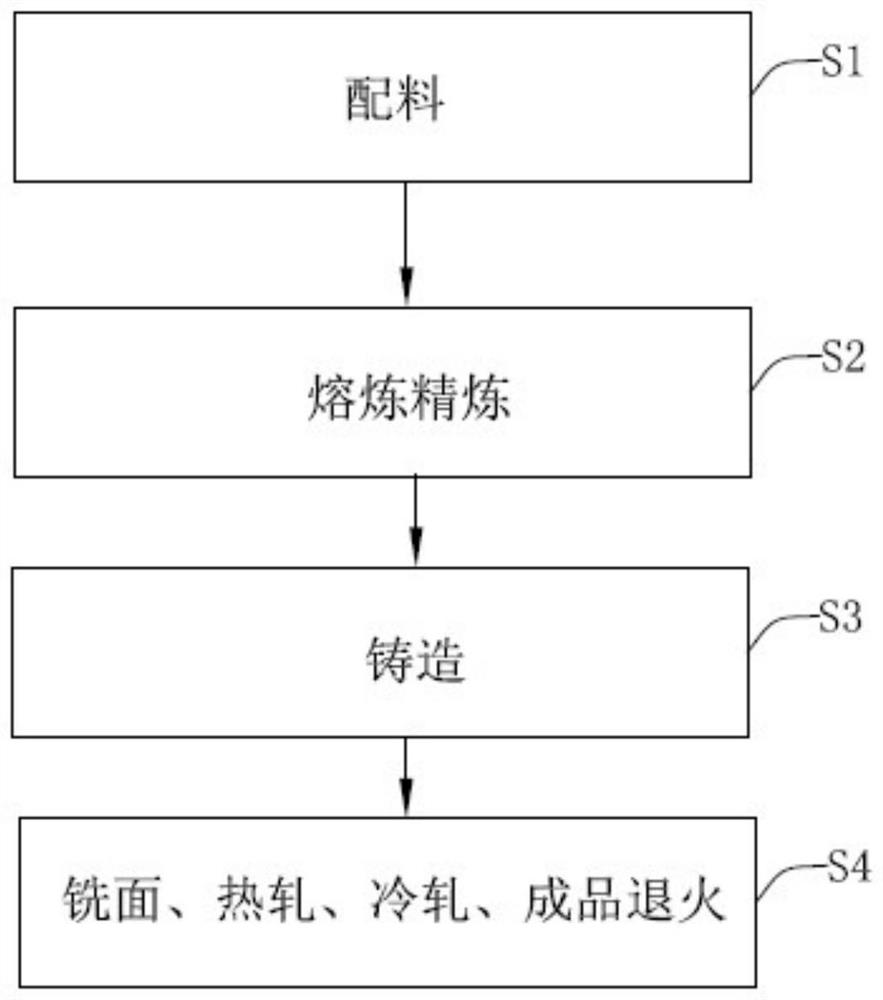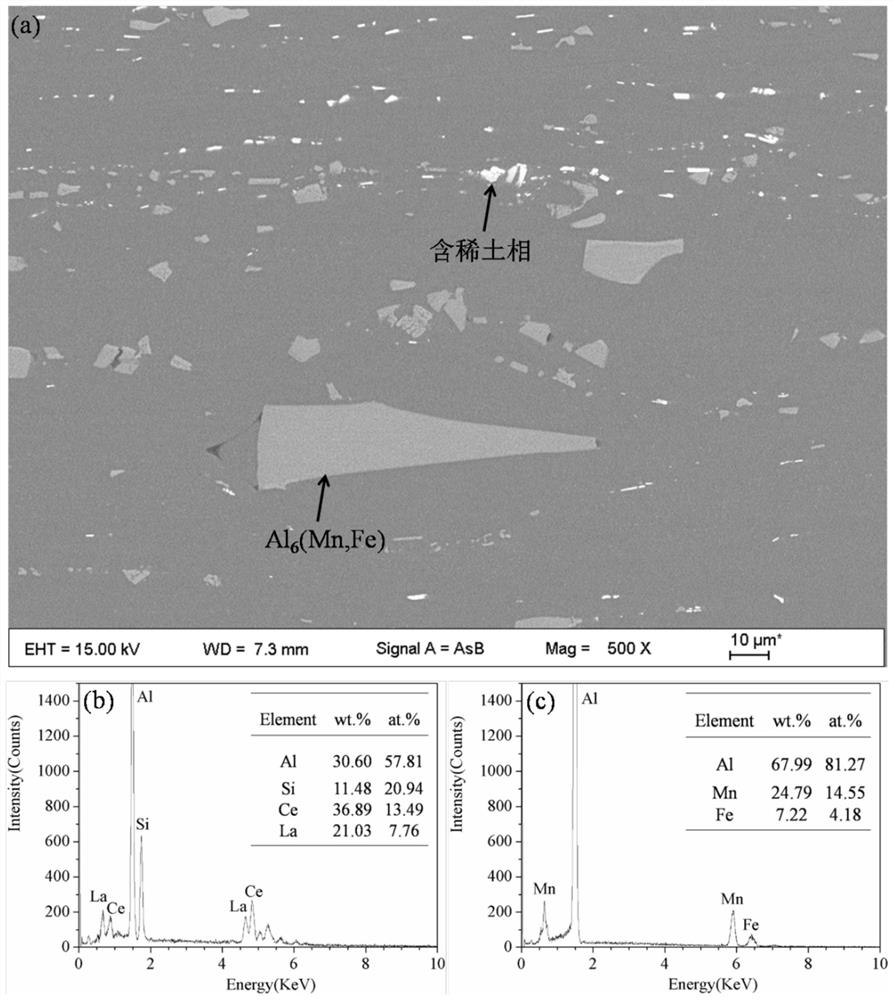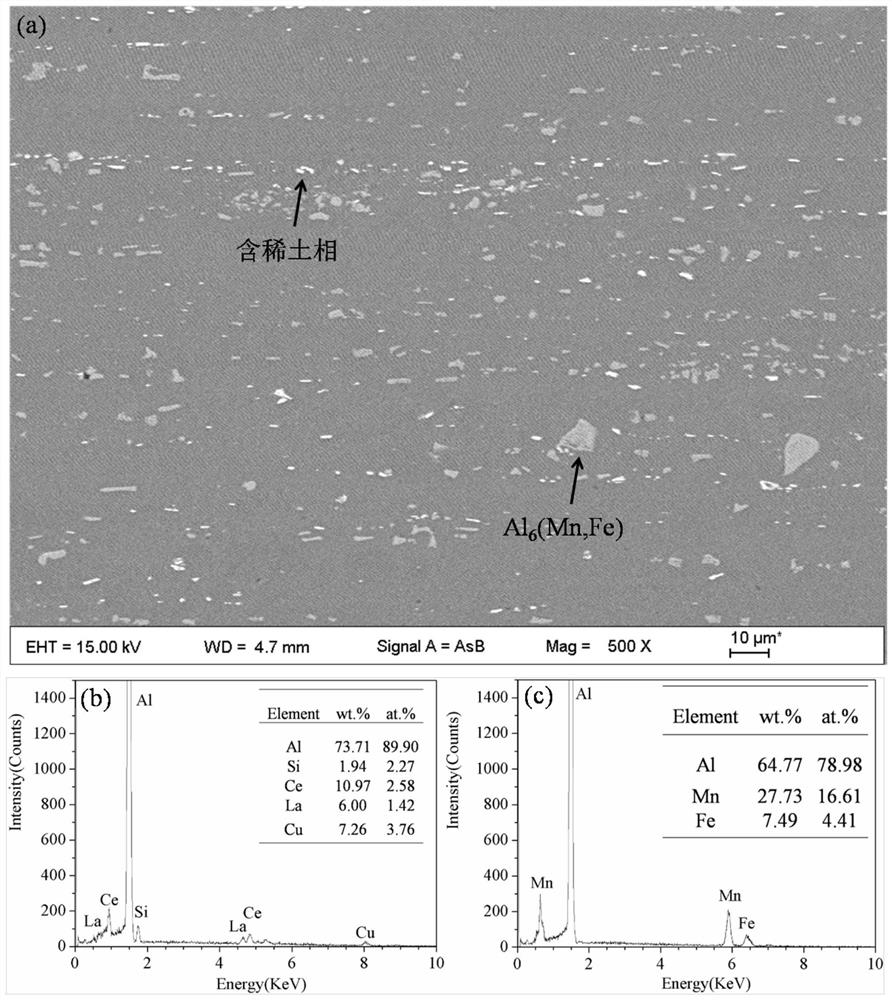Al-Mn alloy and production method thereof
An aluminum-manganese alloy and production method technology, applied in the field of aluminum alloys, can solve the problems of high price of rare earth elements samarium and samarium, limited improvement of alloy performance, limited effect of improving strength, etc., to achieve effective pinning effect, increase particle size, and reduce cost. low effect
- Summary
- Abstract
- Description
- Claims
- Application Information
AI Technical Summary
Problems solved by technology
Method used
Image
Examples
Embodiment 1
[0035] The present embodiment provides a kind of production method of aluminum-manganese alloy, and this production comprises the following steps:
[0036] Step S1, ingredients: Al-Mn alloy raw materials are formulated according to the following components and mass percentages: 0.16% silicon, 0.23% iron, 1.65% manganese, 0.32% copper, 0.15% zirconium, 0.36% cerium; 0.16% lanthanum, and the balance is Aluminum and unavoidable impurities.
[0037] In this embodiment, the silicon-controlled content is strictly controlled not to exceed 0.2%, because excessive silicon will combine with cerium and lanthanum to form a larger particle size of the second phase, such as the attached figure 2 shown, with figure 2 It is the scanning photo and energy spectrum analysis results of the second phase particles of the alloy sheet containing more than 0.2% silicon: (a) the scanning photo of the second phase particles; (b) the picture shows the results of energy spectrum analysis of the rare ea...
Embodiment 2
[0046] The production method in the second embodiment is roughly the same as that in the first embodiment, except that when step S1 is carried out, the mass percentages of the components in the aluminum-manganese alloy raw material can also be: 0.13% silicon, 0.33% iron, manganese 1.38%, copper 0.58%, zirconium 0.23%, cerium 0.26%; lanthanum 0.24%, the balance is aluminum and unavoidable impurities.
[0047] The mass percent of each component in the aluminum-manganese alloy produced in Example 2 is: silicon<0.2%, iron<0.5%, manganese 1.0%-1.8%, copper 0.3%-0.9%, zirconium 0.1%-0.3% , cerium 0.05%-0.4%; lanthanum 0.1%-0.4%, the balance is aluminum and unavoidable impurities. And the aluminum-manganese alloy can be used in heat exchange devices, especially brazing thin plates or fins or the core material of brazing composite aluminum materials, the yield strength after brazing is higher than other alloys, and has good room temperature strength and high temperature resistance. ...
Embodiment 3
[0049] The production method in the third embodiment is roughly the same as that in the first embodiment, except that, when step S1 is carried out, the mass percentages of the components in the aluminum-manganese alloy raw material can also be: 0.11% silicon, 0.43% iron, manganese 1.15%, copper 0.84%, zirconium 0.28%, cerium 0.18%; lanthanum 0.35%, the balance is aluminum and unavoidable impurities.
[0050] The mass percent of each component in the aluminum-manganese alloy produced in Example 3 is: silicon<0.2%, iron<0.5%, manganese 1.0%-1.8%, copper 0.3%-0.9%, zirconium 0.1%-0.3% , cerium 0.05%-0.4%; lanthanum 0.1%-0.4%, the balance is aluminum and unavoidable impurities. And the aluminum-manganese alloy can be used in heat exchange devices, especially brazing thin plates or fins or the core material of brazing composite aluminum materials, the yield strength after brazing is higher than other alloys, and has good room temperature strength and high temperature resistance. ...
PUM
| Property | Measurement | Unit |
|---|---|---|
| thickness | aaaaa | aaaaa |
Abstract
Description
Claims
Application Information
 Login to View More
Login to View More - Generate Ideas
- Intellectual Property
- Life Sciences
- Materials
- Tech Scout
- Unparalleled Data Quality
- Higher Quality Content
- 60% Fewer Hallucinations
Browse by: Latest US Patents, China's latest patents, Technical Efficacy Thesaurus, Application Domain, Technology Topic, Popular Technical Reports.
© 2025 PatSnap. All rights reserved.Legal|Privacy policy|Modern Slavery Act Transparency Statement|Sitemap|About US| Contact US: help@patsnap.com



